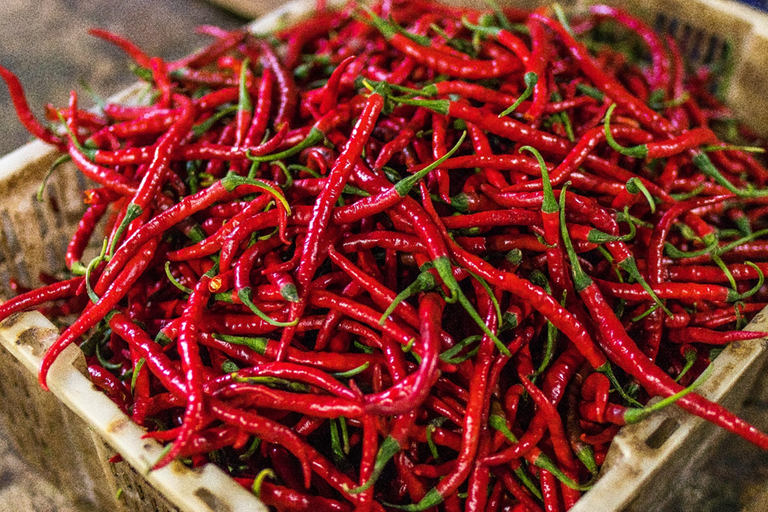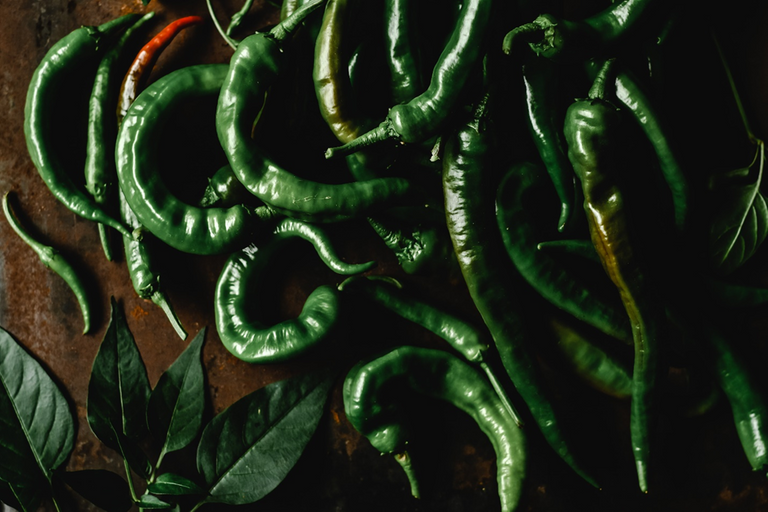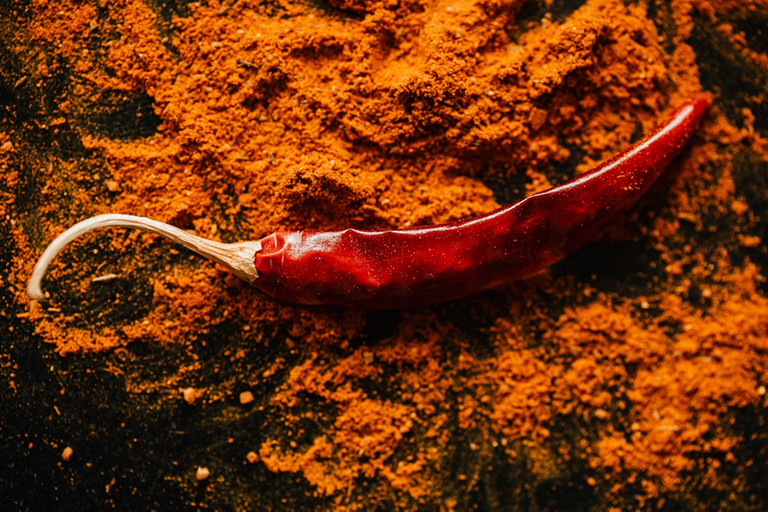Ají, Pimiento, Chili.
“Palabras con las que conocemos al fruto del Capsicum, quienes los dispersaron por el mundo. Receptores del dolor”.
Me gusta el ají, y aún con todas las alarmas que se disparan en el cuerpo, ojos llorosos, calor excesivo en la lengua, hipo o tos, ver un jalapeño o los pequeños picantes tailandeses me hacen salivar. Disfruto de una comida con chili, me recuerden a papa preparando salsa picante, y en vez de agua o aceite, él usaba leche. Tengo mucho tiempo sin ver y saborear un "suero picante", que es como se conoce a esta salsa en Venezuela.

Pimientos rojos - Red hot peppers, Pexels
Comienzo aclarando que usaré estas palabras como sinónimos: ají, chili y pimiento para referirme al Capsicum, que es un género de plantas florales, de tipo arbusto, originaria de las regiones tropicales y subtropicales de América, cuyos frutos y derivados son picantes.
Haxí, axí o ají es la palabra usada en las poblaciones nativas caribeñas y en Sudamérica, que fue aceptada y extendida por los conquistadores durante la exploración del continente.
Pimiento fue acuñado por los españoles por comparación con el único elemento similar conocido por ellos, la pimienta.
La palabra chili proviene del náhuatl “chilli”, lenguaje más hablado por los habitantes del centro de Mexico. Este vocablo es de amplio uso en Mexico y Centroamérica.
En toda latinoamerica se consume el chili, excepto posiblemente Argentina y Uruguay. Venezuela tiene muy baja tolerancia al picante, el resto de los paises de esta region lo usan con mayor frecuencia.
Cristóbal Colon fue el primero que llevo el chili a España en su segundo viaje, y desde allí paso a Italia, pero los portugueses también encontraron muchas poblaciones indígenas que lo consumían en Brasil. Así que ambos países se encargaron de propagar por todo el mundo al ají. Actualmente es una de las especies más comúnmente usadas, cultivadas en casi todos los continentes y consumida diariamente por un gran porcentaje de la población mundial.

Ají verde - Green chili pepper, Pexels
Ají, Pimiento, Chili / Hot pepper, Chili pepper.
"Words with which we know the fruit of the Capsicum, who dispersed them around the world. Pain receptors".
I like chili peppers, and even with all the alarms going off in my body, watery eyes, excessive heat on my tongue, hiccups or coughs, seeing a jalapeño or the little Thai peppers make me salivate. I enjoy a meal with chili, remind me of dad preparing hot sauce, and instead of water or oil, he used milk. It has been a long time since I have seen and tasted a "suero picante" (spicy serum), which is how this sauce is known in Venezuela.
I begin by clarifying that I will use these words as synonyms in Spanish of hot pepper, chili pepper (ají, chili and pimiento) to refer to Capsicum, which is a genus of flowering plants, shrub-like, native to the tropical and subtropical regions of America, whose fruits and derivatives are spicy.
- Haxí, axí or ají is the word used in the native Caribbean populations and in South America, which was accepted and extended by the conquerors during the exploration of the continent.
- Pimiento was coined by the Spaniards by comparison with the only similar element known to them, the pepper.
- The word chili comes from the Nahuatl "chilli", the language most widely spoken by the inhabitants of central Mexico. This word is widely used in Mexico and Central America.
Chili peppers are consumed throughout Latin America, except possibly Argentina and Uruguay. Venezuela has a very low tolerance to hot peppers, and the rest of the countries in this region use them more frequently.
Christopher Columbus was the first to take chili peppers to Spain on his second voyage, and from there to Italy, but the Portuguese also found many indigenous populations that consumed it in Brazil. So both countries were in charge of spreading chili peppers all over the world. It is currently one of the most commonly used species, cultivated in almost all continents and consumed daily by a big percentage of the world's population.

Chili rojo y especies molidas - Red chili pepper and ground spices, Pexels
Capsaicina = dolor
La capsaicina es responsable por la sensación de dolor y de quemaduras que recibimos al consumir pimientos. El receptor de potencial transitorio V1 (TRPV1 por sus siglas en ingles) presente en nuestros genes responde al calor sobre 43C - 109F, medio acido (pH bajo), a la capsaicina en el ají y a la alicina en el ajo.
Lo curioso es que, en realidad, no hay daño físico, como en el caso de una quemadura por tomar café excesivamente caliente. Es un medio para disuadir a los mamíferos de consumir este fruto. Nosotros los humanos tendemos a triturar las semillas, y nuestro sistema digestivo las descompone evitando su germinación, convirtiéndonos en una amenaza para los pimientos.
Las aves, quienes excretan las semillas enteras e intactas, y actúan como dispersores de las simientes, son inmunes a la capsaicina, posiblemente es una recompensa biológica por propagar a las plantas de ají.
“En futuros posts tendremos información sobre usos del pimiento en nuestra vida diaria, medicinal y otros. Escala para medir cuan picante es un ají. Producción y consumo a nivel mundial.”
Capsaicin = pain
Capsaicin is responsible for the pain and burning sensation we receive when consuming peppers. The transient receptor potential V1 (TRPV1) present in our genes responds to heat above 43C - 109F, medium acid (low pH), to capsaicin in chili peppers and to allicin in garlic.
The curious thing is that there is actually no physical damage, as in the case of a burn from drinking excessively hot coffee. It is a means of deterring mammals from consuming this fruit. We humans tend to crush the seeds, and our digestive system breaks them down preventing their germination, making us a threat to the chili peppers.
Birds, who excrete the seeds whole and intact, and act as seed dispersers, are immune to capsaicin, possibly a biological reward for propagating chili pepper plants.
"In future posts we will have information on uses of chili peppers in our daily lives, medicine and others. Scale for measuring how hot a chili pepper is. Worldwide production and consumption."
Recursos - Resources:
Libros - books:
La historia secreta de la comida - The secret history of food, por - by Matt Siegel.
La complicada evolucion del chili picante - The complicated evolution of the spicy chili pepper, por - by Cat Adams.
Fotografias - Pictures: Pexels